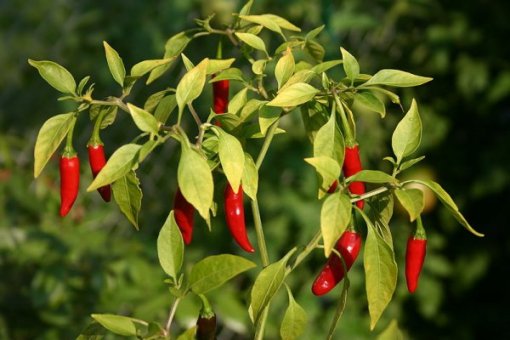For some time Cinta Laura Kiehl, born 17 August 1993 in Quakenbruck, Germany, has been neck and neck with cabai rawit — the little green ones — for hottest Indonesian hottie. Her first CD– Cinta Laura –has gone double platinum in 5 weeks. It’s got to be finger-lickin’ good or else Colonel Sanders wouldn’t be promoting it.
According to the Jakarta Globe, Indonesian agriculture minister Suswono has told Indonesians to “grow chili” in their back yards to offset the high prices of “spices” this year. What is meant is chili peppers, most of which which — including rawit, jalepeños and cayennes but also bell peppers — belong are of the species Capsicum annum. (No relation to black pepper, a tropical vine.)
Indonesia is set to consume 1.2 million tons of what Indonesians call cabai or here in Jakarta cabe.
In fact, it’s more than a spice. In 2007 the country’s maize and casava production — the most important staples after rice — were themselves only 13.3 and 19.9 tons respectively.
And of course they’re healthy and full of vitamins (although Indonesians — just like everyone I guess — merrily exchange guilt trips on each other for eating food that’s “too hot”). The long green chilis here in Jakarta aren’t very hot at all, while any chili can be “chilled out” by removing the seeds. Anyway, I can think of plenty of local dishes where chili peppers would be the second most important ingredients (and not sauces ).
The primary reason for the failure of the capsicum crop — and the high prices — is extreme weather, in this case unexpected rain. But lack of refrigeration is said to have played a part. I think the real problem is that everyone just throws away leftover chilis — oversupply. I’ve never seen the maids dry a chili pepper. They just throw them out and buy more when their complexion and je ne sais quois mouth-watering quality no longer brings Miss Kiehl to mind.
Chilis were normally around Rp 20,000 to Rp 30,000 / kilo. Like bawang putih, or garlic, there were traditionally so many of them in the Sharehouse crisper they were de facto shared food, irrespective of the terms of any pertinent sublease agreement. Then normal, for a while, was Rp 40,000 to Rp 50,000 and people tried to keep track of their little Indonesian hotties a little better. Domestic staff was instructed to not to store the small dudes all mixed with other roots, bark and berries in the little black plastic bags they give away free at the wet markets.
And now it’s come to this: grow your own. I know one guy on the block who does. And once the maid did plant some chili seeds in the front yard. It must be Indonesian instinct. The minister says “come up with some pots or rack — which will in fact work for any type of vegetable.” The soil would also be a nice touch. That has been a little scarce here in Jak recently. 
He also insists that chili pepper aren’t a staple and that if people would just stop eating them for “2 or 3 days” — doggone it –prices would fall. Desperate. Bell peppers have been unaffordable here for years. Likely as not, it is the beginning of end times here in Jak.
Chili seeds are to be distributed free to about 100,000 households in Lampung, Banten, West Java and “possibly Jakarta.” If you don’t like the taste of those, here are some hot chili pepper gardening links for Indonesia.

Luar biasa. You started the post with Cinta Laura Kiehl and ended it with chili pepper gardening links. Keren! 😀
And this is just straight up hilarious: “He also insists that chili pepper aren’t a staple and that if people would just stop eating them for “2 or 3 days” — doggone it –prices would fall.”
hahaha. thanks, i thought this one was approved. I also had to laugh wondering what happened that day. Too much time to blog I guess
woooo nice like chili
Interresting, please send me more. Grtz Walt
i hear this particular Indonesian model might already be a German . . . not sure what to say